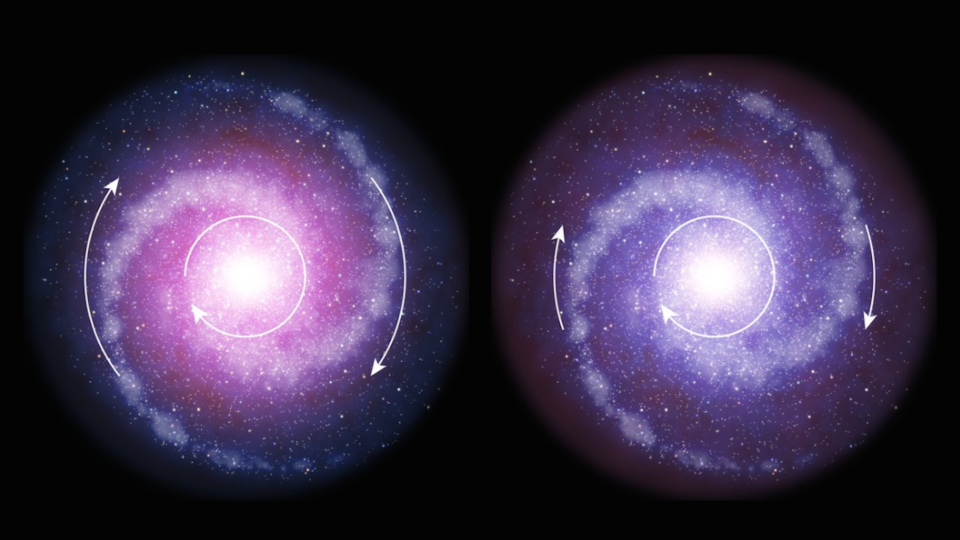Each month, renowned astronomers share their latest research at Morrison Planetarium.
Universe Update
The Dark Is Rising

Schematic representation of rotating disc galaxies in the early Universe (right) and the present day (left). Observations with ESO's Very Large Telescope suggest that such massive star-forming disc galaxies in the early Universe were less influenced by dark matter (shown in red), as it was less concentrated.
[Editors’ note, 20 March 2017. We ran across this blog post by Stacy McGaugh at Case Western Reserve University, which offers compelling arguments to question the results we describe below. One more example of the scientific process at work! More data will be required to resolve the question…]
Dark matter gives the Universe its heft. The elusive stuff makes up almost 27 percent of the Universe, while the stuff we can see—stars, dust, and gas—makes up less than 5 percent (dark energy fills in the rest).
While dark matter is visually unobservable (you can think of it as “invisible matter”), one reason we know it exists is because we see its influence on the rotation of spiral galaxies. We find high concentrations of stars in the centers of spiral galaxies, but the density of bright matter decreases towards their outskirts. If a galaxy’s mass consisted entirely of normal (or as scientists call it, baryonic) matter, then the sparser outer regions should rotate more slowly than the dense regions at the center. But observations of nearby spiral galaxies show that their inner and outer parts actually rotate at approximately the same speed. These “flat rotation curves” indicate that spiral galaxies must contain large amounts of non-luminous matter in a dark matter halo surrounding the galactic disc.
But four studies published today say this wasn’t always so. A team of astronomers, observing several star-forming galaxies from the peak of galaxy formation around 10 billion years ago, found that the outer regions of these distant, ancient galaxies seem to be rotating more slowly than the region near the core, suggesting the galaxies contain less dark matter and more normal matter.
“Surprisingly, the rotation velocities are not constant, but decrease further out in the galaxies,” says Reinhard Genzel, lead author of one of the papers, published in Nature. “There are probably two causes for this. First, most of these early massive galaxies are strongly dominated by normal matter, with dark matter playing a much smaller role than in the local Universe. Second, these early discs were much more turbulent than the spiral galaxies we see in our cosmic neighborhood.”
Both effects seem to become more marked as astronomers look farther and farther back in time, into the early Universe. This suggests that three to four billion years after the Big Bang, the gas in galaxies had already efficiently condensed into flat, rotating discs, while the dark matter halos surrounding them were much larger and more spread out. Apparently it took billions of years longer for dark matter to condense as well, so its dominating effect is only seen on the rotation velocities of galaxy discs today.
This explanation is consistent with observations showing that early galaxies were much more gas-rich and compact than today’s galaxies.
“We have to be very careful when comparing these early massive and gas-rich rotating galaxies to the ones in our local universe,” cautions Natascha Förster Schreiber, co-author for all four studies. “Present-day spirals, such as our Milky Way, require additional dark matter in various amounts. On the other hand, local passive galaxies—which are dominated by a spheroidal component and are the likely descendants of the galaxies in our study—show similarly low dark matter fractions on galactic scales.”
Image: ESO/L. Calçada